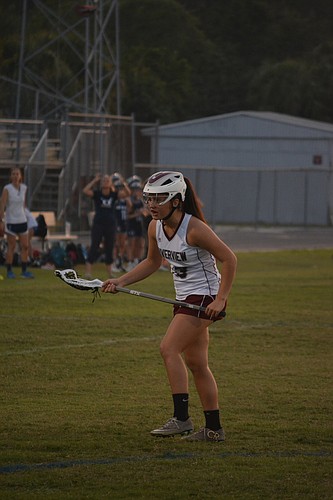- May 12, 2025
-
-
Loading

Loading

Girls lacrosse season starts next week, and for teams across Florida, things will look — and feel — a bit different this year.
The Florida High School Athletic Association passed a rule in 2015 mandating all girls lacrosse players wear helmets starting in 2018, becoming the first state athletic association to pass such a rule. In theory, the rule is meant to prevent concussions, which are a problem within the sport. It was originally supposed to go into effect immediately, but it was put off until now under pressure from US Lacrosse. At the time, US Lacrosse’s vice president of operations, Ann Kitt Carpenetti, called the rule “irresponsible” for not mandating helmets that, in her estimation, will actually protect people.
A 2015 study from Injury Epidemiology said girls lacrosse has the second-highest concussion rate of any sport, boys or girls, behind football (which is way ahead of the pack). The study said the majority of concussions in girls lacrosse were caused by blows to the head from an object (i.e. the stick). Boys lacrosse concussions were mainly caused by collisions between two players.
The new helmets are being made by two FHSAA-approved manufacturers, Hummingbird Sports (based in New Jersey) and Cascade (based in New York). Both helmets cost approximately $150 at retail stores, though teams can get discounts for buying in bulk.
Riverview High, in anticipation of the change, started wearing helmets last season to get accustomed to them. Prior to that, the program wore “halos,” or protective headbands, and goggles. This makes the Rams uniquely qualified to talk about the switch, and it turns out people's feelings on the subject are mixed.
Coach Ashley McLeod said she would leave the issue “to people above her pay grade,” but did note that US Lacrosse has come out against the rule. While US Lacrosse still does not require helmets of any kind, the organization has put forth standards for optional headgear so the FHSAA-approved manufacturers at least had something to follow. This means the helmets are “flexible,” not hard like boys helmets, as to not injure players in states without regulations like Florida's. Whether this limits the effectiveness of the helmets, as Carpenetti feared, remains to be seen, but Riverview is able to talk about its year of experience.
“I don’t know if they really helped with concussions,” McLeod said. “We still had a concussion (last season) even with them. But who knows how many more concussions we would have had? I’m not a doctor, I don’t know.”
McLeod added she didn’t believe the helmets caused her team to play any more or less physically than in the past, which goes against the so-called “gladiator effect,” a theory that athletes get more aggressive when wearing more protection. It’s one argument used in certain football circles that maintain concussions would drop if much of the protection was removed, like in rugby.
Rams players took more of a stance on the issue: they don't like the helmets.
“They give you migraines,” sophomore Lily Dougherty said. “It hurts to wear them.”
Dougherty noticed no difference in safety during play with the helmets, and said if given the choice, she’d want to wear the protective headbands instead.
Senior Veronica McCurdy, the team’s top goal scorer, agreed that the helmets were “pretty tight” and required a breaking-in period to get comfortable. All things being equal, she wouldn’t wear them, either. McCurdy also noted that goalies in girls lacrosse have been required to wear helmets, boys helmets, forever, and she’s seen a few goalies leave games with concussions in the past.
“You still run the risk, even with helmets,” she said.
There are other concerns, too, like accessibility. High school teams may get discounts, but individual youth athletes won’t, meaning a game once able to be played (relatively) inexpensively now adds a new expense, turning away some potential players.
Ultimately, there will be one determining factor in the success of this experiment, and that’s if concussion rates fall in Florida girls lacrosse now. If they do, the helmets will be worth the discomfort and cost, but we won’t have the answer to that for quite a while.